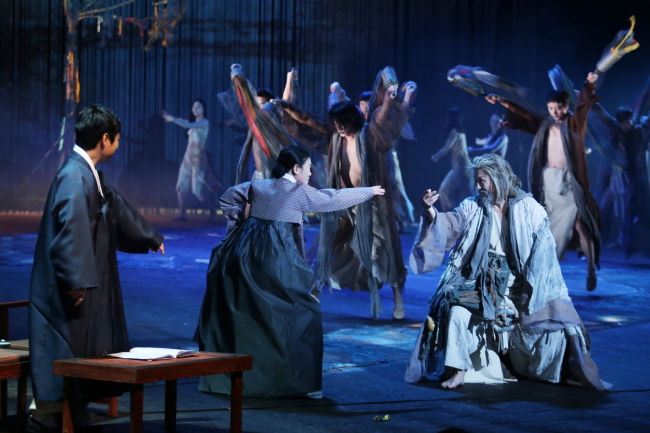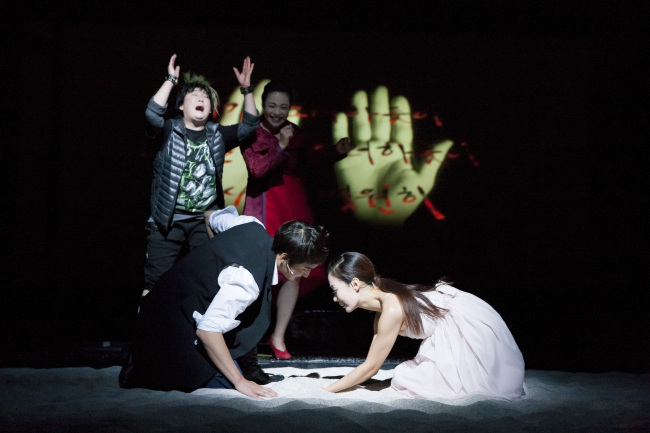[Herald Review] Two stage masters experiment with gugak
‘Gongmudoha,’ ‘Different Chunghyang’ reinvent Korean tradition in their own ways
By Korea HeraldPublished : Nov. 24, 2014 - 20:53
Korean stage director Lee Youn-taek calls himself a “cultural nationalist.”
He openly criticizes historians for confusing the history of Korean theater with that of Western theater in Korea, asking, “Did we, Koreans, really have no theater until 1910?”
Andrei Serban is a Romanian-born American director who regards himself as an “experimental artist.”
Reinventing Greek tragedy or Chekhov with provocative visual images and iconoclastic new interpretations, he has made a name for himself in the Western world of theater.
The two stage masters who seem to have nothing in common have become the talk of Seoul’s performing arts scene on account of two works that both intend to do the same thing ― reinvent Korean tradition.
‘Gongmudoha’
Lee’s work “Gongmudoha (Don’t Cross That River)” premiered Friday, packing almost every element of local tradition, from court music to shamanism, into an original opera.
With a gugak orchestra, accompanied by a conductor, in the pit, the show begins with two narrators ― played by pansori masters ― conversing about the origins of Korean theater, which they say can be found in the ancient poem “Gongmudoha.”
Thought to be the oldest lyric poem in Korea, it tells of a crazy old man who attempts to walk across a river, only to drown, leaving his wife in a bottomless pit of sadness. It starts with the famous first line “My love, don’t cross that river.”
He openly criticizes historians for confusing the history of Korean theater with that of Western theater in Korea, asking, “Did we, Koreans, really have no theater until 1910?”
Andrei Serban is a Romanian-born American director who regards himself as an “experimental artist.”
Reinventing Greek tragedy or Chekhov with provocative visual images and iconoclastic new interpretations, he has made a name for himself in the Western world of theater.
The two stage masters who seem to have nothing in common have become the talk of Seoul’s performing arts scene on account of two works that both intend to do the same thing ― reinvent Korean tradition.
‘Gongmudoha’
Lee’s work “Gongmudoha (Don’t Cross That River)” premiered Friday, packing almost every element of local tradition, from court music to shamanism, into an original opera.
With a gugak orchestra, accompanied by a conductor, in the pit, the show begins with two narrators ― played by pansori masters ― conversing about the origins of Korean theater, which they say can be found in the ancient poem “Gongmudoha.”
Thought to be the oldest lyric poem in Korea, it tells of a crazy old man who attempts to walk across a river, only to drown, leaving his wife in a bottomless pit of sadness. It starts with the famous first line “My love, don’t cross that river.”

The narrators then start sharing their guesses as to why the man in the poem tried to cross the river, leading to the show’s two parallel stories.
One is about a man who gets lost in Seoul’s maze of apartment buildings and travels to the past and to his former life. The other is a love story between a South Korean man and North Korean woman. The man crosses the river between China and North Korea and enters the communist country to find his love.
Dramatically, some parts of the show feel cliched. Particularly so when the South Korean man sings “Our Hope is the Unification.”
But musically, it beautifully weaves together different types of gugak and transforms traditional sounds into a perfect overture, duet or aria.
The rough and raw voice and heavy vibrato of pansori singers ― who play the main roles ― work to amplify emotions.
The stage is simple, but cleverly decorated. With the change of background images, the scene changes from Seoul’s concrete jungle to the surreal time and space of the man’s previous life.
An illuminated S-shaped sign on the floor of the stage stays on throughout the show, symbolizing a river that bisects the present and the past, or the two Koreas.
‘Different Chunhyang’
Everything in Serban’s “Different Chunhyang” is different from the previous productions of the classical Korean love story. From the settings, dialogues and costumes to the ending, everything has been changed, except the music ― pansori, traditional Korean narrative singing.
In his reincarnation, Seong Chun-hyang, the female lead who, in the original story, is pure and innocent and risks her life to be faithful to her husband Lee Mong-ryong, is a brave heroine who fights against corruption and injustice and adheres to the ideal of love.

Mong-ryong, who in the original story is the son of a nobleman, is a college student from Seoul who meets Chun-hyang and falls in love during his brief stay in the countryside. When he returns to Seoul, he is too busy clubbing and having fun and forgets her.
In this newer yet similar plot, Serban focuses less on their love, and more on each character’s desires. He asks the audience what makes Chun-hyang stay faithful and suffer time in jail. Is it for love or because of Chun-hyang’s own strong ego? Mong-ryong’s return to Namwon, where he met Chun-hyang, also raises questions about his political ambition and his forgotten love for her.
“Like Shakespeare’s stories, you can turn the story upside down, improvise and do the craziest experiments to recreate,” Serban said at a news conference before the premiere.
The creative set keeps the audience enticed for two hours, with spiral stairs and a video screen in the background that tells another side of the story. Those who expect a plaintive love story might be disappointed, but they will surely get a unique interpretation of “Chunhyang,” filled with the strong energy of pansori.
A production of the National Gugak Center, “Gongmudoha” runs through Nov. 30 at Yeakdang (Main Hall) at the NGC, located near Seocho Station on Line No. 3. Ticket prices range from 10,000 won to 50,000 won. For more information, visit www.gugak.go.kr or call (02) 580-3300.
The National Changgeuk Company production of Andrei Serban’s “Different Chunhyang” runs through Dec. 6 at the Daloreum Theater at the National Theater of Korea, Jangchung-dong, central Seoul. Ticket prices range from 20,000 won to 50,000 won and English translation is provided. For more information, visit www.ntok.go.kr or call (02) 2280-4114.
By Lee Sun-young & Ahn Sung-mi
(milaya@heraldcorp.com) (sahn@heraldcorp.com)
-
Articles by Korea Herald



![[Herald Interview] 'Amid aging population, Korea to invite more young professionals from overseas'](http://res.heraldm.com/phpwas/restmb_idxmake.php?idx=644&simg=/content/image/2024/04/24/20240424050844_0.jpg&u=20240424200058)













![[KH Explains] Korean shipbuilding stocks rally: Real growth or bubble?](http://res.heraldm.com/phpwas/restmb_idxmake.php?idx=652&simg=/content/image/2024/04/25/20240425050656_0.jpg&u=)

